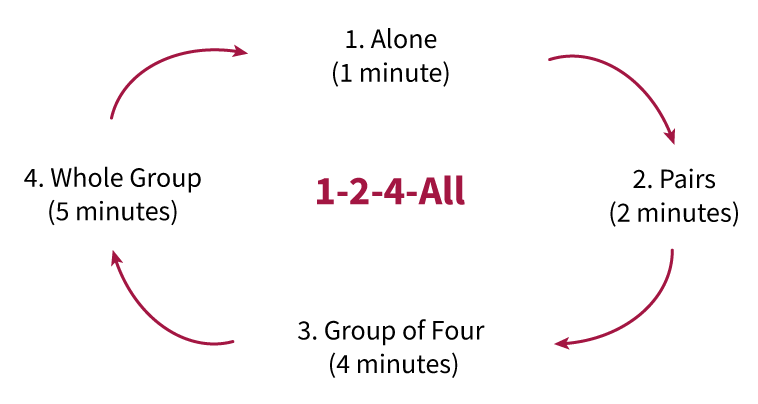# Ideate
# 1-2-4-All
- Purpose
- Joint generation of questions, ideas and suggestions
- Time required
- 20 minutes
- Participants
- Design Thinking team
- Level of experience
- Beginner

# What is it about?
This method integrates all participants and generates a common understanding in an effective way.
# The goal
The aim of this method is to avoid groupthink and to fully broaden the spectrum of opinions. This is achieved by integrating all participants equally. People who are more reserved in group situations can thus also be given a voice.
# How to do it?
- Formulate a question that relates to a topic presented in advance.
- Each person spends one minute alone thinking about the selected problem.
- In pairs, develop these ideas further together in two minutes.
- Then sit together in a group of four and refine the ideas from the pair session in four minutes.
- Discuss in the whole group which ideas stood out the most in the groups.
# When do you need it?
1-2-4-All creates protected spaces to involve everyone in the search for solutions and thus minimizes the influence of power relations. This tool is also suitable for optimizing the quality of findings before they are shared in the group. This creates a common understanding in a natural way.
# Resources
- paper
- pens
# Advantages
All participants are involved in the process of generating ideas. This avoids a vicious circle of paternalism, as a protected space for exchange is created. In addition, a wide variety of ideas can be generated, which can lead to innovative solutions. The communication and personal responsibility of the team members increases trust.
# Disadvantages
Due to a lack of diversity among those involved, the spectrum of opinions may not be fully revealed. There is also a risk that the root causes will not be recognised and the solutions will therefore only have a temporary effect.
# Keep in mind
Idea generation should be isolated from the group discussions and each phase should be announced using a timer. In addition, only one conversation should be held at a time in the entire group.
# See also
| Previous methods | Alternative methods | Following methods |
# Sources
- 1-2-4-All (German) (opens new window) Liberating Structures - Innovation durch echte Zusammenarbeit.
← Shadowing 2x2 Matrix →